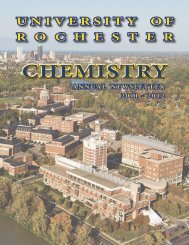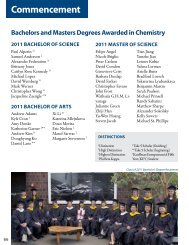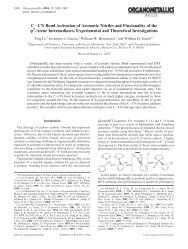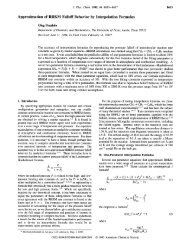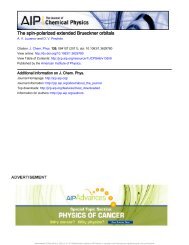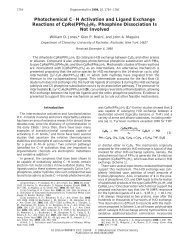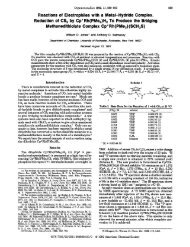ch 41.2.2-kadosh - Chemistry
ch 41.2.2-kadosh - Chemistry
ch 41.2.2-kadosh - Chemistry
Create successful ePaper yourself
Turn your PDF publications into a flip-book with our unique Google optimized e-Paper software.
6<br />
autocorrelation function with a substantial amplitude is<br />
indicative of a correlated evolution of the dye excited<br />
state. The Fourier transform of the autocorrelation function<br />
shown in Fig. 3c peaks at 1600 cm –1 . This frequency<br />
is within the range associated with a carbon stret<strong>ch</strong>,<br />
immediately revealing the origin of the oscillation.<br />
Since the first excited state of the <strong>ch</strong>romophore is a<br />
π-state localized on the ring carbons, an oscillation of<br />
the ring carbons should modulate the energy of the state.<br />
In order to establish the types of ion motions available<br />
at the 1600 cm –1 frequency, Fourier transforms of<br />
velocity autocorrelation functions of all atoms in the<br />
combined system have been computed. The result is<br />
shown in Fig. 3d on a logarithmic scale. Only <strong>ch</strong>romophore<br />
carbon and nitrogen atoms exhibit motions with<br />
frequencies near 1600 cm –1 , with the peak at 1600 cm –1<br />
dominated by the three middle carbons. The first excited<br />
state of the dye is localized on the four middle carbons:<br />
The persistent oscillation of the dye excited state energy<br />
shown in Fig. 3a is indeed due to a C–C-stret<strong>ch</strong>ing<br />
mode.<br />
In the combined dye–TiO 2 system, the dye excited<br />
state interacts with the TiO 2 conduction band. As a<br />
result, the adiabatic states represented in the one-electron<br />
picture by the Kohn–Sham orbitals of the combined<br />
system are, generally, delocalized between the <strong>ch</strong>romophore<br />
and the semiconductor. It is assumed in the<br />
current simulation that photoexcitation promotes an<br />
electron into the adiabatic state with the largest localization<br />
on the dye. This is expected with strong excited<br />
state selection rules with transition dipole moments<br />
favoring excitation of the dye fragment, or with relatively<br />
long laser pulses that by the time–energy uncertainty<br />
relationship can select a state with a stationary,<br />
adiabatic state of a given energy. The opposite limit is<br />
the diabatic excitation, where the laser excites a superposition<br />
of adiabatic states that best corresponds to the<br />
dye excited state in the absence of a semiconductor. The<br />
details of the photoexcitation realized in experiments<br />
depend on both properties of the dye–semiconductor<br />
system, su<strong>ch</strong> as transition dipole moments between<br />
ground and excited states, and properties of the laser<br />
pulse, su<strong>ch</strong> as its shape, duration, and polarization. Investigation<br />
of the photoexcitation details extends beyond<br />
the scope of the present study, whi<strong>ch</strong> takes the<br />
adiabatic excitation limit. Figure 4a shows localization<br />
L p of the photoexcited state φ p<br />
Israel Journal of <strong>Chemistry</strong> 42 2002<br />
(9)<br />
on the <strong>ch</strong>romophore along the production run. The<br />
photoexcited state is defined in the adiabatic limit as the<br />
state with the largest localization on the dye, <strong>ch</strong>osen<br />
within a range of states of the combined system at the<br />
energies corresponding to the excited state energy of the<br />
isolated <strong>ch</strong>romophore, Fig. 2c. The degree to whi<strong>ch</strong> the<br />
photoexcited state is localized on the dye varies substantially<br />
along the trajectory. In many instances the<br />
photoexcited state is localized on the dye 80% or more,<br />
similar to our previous low temperature simulation. 34<br />
Very often, the photoexcited state is less than 50%<br />
localized on the dye. In su<strong>ch</strong> cases, the excited state of<br />
the isolated <strong>ch</strong>romophore, the diabatic state, contributes<br />
to several, typically 2 or 3, adiabatic states of the combined<br />
system; see Fig. 5a below.<br />
A closer look at the data of Figs. 3a and 4a reveals<br />
that the localization of the photoexcited state on the dye<br />
has the same fluctuation as the energy of the photoexcited<br />
state. The autocorrelation function<br />
(10)<br />
of the localization of the initial state, Fig. 4b, and its<br />
Fourier transform, Fig. 4c, are very similar to those of<br />
the state energy, Figs. 3b and 3c. The localization oscillates<br />
with the same frequency as the energy. This result<br />
can be expected, since the density of states in the conduction<br />
band grows with energy, Fig. 5b, increasing the<br />
likelihood of interaction and mixing between the dye<br />
and semiconductor states. The localization varies with<br />
energy, and thereby oscillates with the same frequency<br />
as the energy.<br />
The correlation between the energy of the photoexcited<br />
state and its localization on the <strong>ch</strong>romophore<br />
fragment is illustrated in Fig. 4d, whi<strong>ch</strong> shows the data<br />
for the 100 randomly <strong>ch</strong>osen initial conditions. The<br />
correlation is far from perfect; however, a general trend<br />
can be seen very clearly. A higher density of semiconductor<br />
states does not always imply that more states will<br />
be coupled to the dye excited state. The coupling relies<br />
not only on energy resonance, but also on other <strong>ch</strong>aracteristics<br />
of semiconductor states, su<strong>ch</strong> as their localization<br />
at the surface. Fluctuations in the surface structure<br />
cause <strong>ch</strong>anges in the localization and coupling. The<br />
effect of fluctuations in the surface structure is further<br />
emphasized by a finite depth of the TiO 2 slab. The<br />
simulation represents the conduction band continuum<br />
by a finite number of states. Consequently, the coupling<br />
and mixing of the dye excited state with the surface and<br />
bulk states of the substrate is more discretized than it<br />
may be in reality. Although there will be on average a<br />
greater amount of mixing and coupling when the energy<br />
of the dye excited state is high, there will always be<br />
cases where the mixing and localization are more or less








